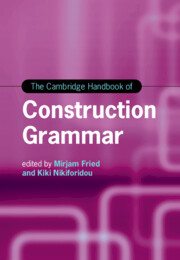Refine search
Actions for selected content:
6584 results in Grammar and Syntax
15 - Beyond Creole: Reflexive Constructions in Cape Verdean Portuguese
- from Part III - The Development of Syntax
-
-
- Book:
- The Evolution, Acquisition and Development of Syntax
- Published online:
- 19 February 2025
- Print publication:
- 06 February 2025, pp 278-298
-
- Chapter
- Export citation
6 - Frequency
- from Part II - Methodological and Empirical Foundations of Constructional Research
-
-
- Book:
- The Cambridge Handbook of Construction Grammar
- Published online:
- 30 January 2025
- Print publication:
- 06 February 2025, pp 149-170
-
- Chapter
- Export citation
Tables
-
- Book:
- The Cambridge Handbook of Construction Grammar
- Published online:
- 30 January 2025
- Print publication:
- 06 February 2025, pp xiii-xiii
-
- Chapter
- Export citation
11 - Syntactic Innovation and Functional Amalgams
- from Part III - Case Studies in Constructional Morphosyntax
-
-
- Book:
- The Cambridge Handbook of Construction Grammar
- Published online:
- 30 January 2025
- Print publication:
- 06 February 2025, pp 290-308
-
- Chapter
- Export citation
Index of Constructions
-
- Book:
- The Cambridge Handbook of Construction Grammar
- Published online:
- 30 January 2025
- Print publication:
- 06 February 2025, pp 656-658
-
- Chapter
- Export citation
Part II - Methodological and Empirical Foundations of Constructional Research
-
- Book:
- The Cambridge Handbook of Construction Grammar
- Published online:
- 30 January 2025
- Print publication:
- 06 February 2025, pp 147-246
-
- Chapter
- Export citation
14 - Insubordination at the Interaction of Discourse, Grammar, and Prosody
- from Part IV - Multimodality and Construction Grammar
-
-
- Book:
- The Cambridge Handbook of Construction Grammar
- Published online:
- 30 January 2025
- Print publication:
- 06 February 2025, pp 354-383
-
- Chapter
- Export citation
Figures
-
- Book:
- The Evolution, Acquisition and Development of Syntax
- Published online:
- 19 February 2025
- Print publication:
- 06 February 2025, pp vii-vii
-
- Chapter
- Export citation
12 - Constructions in Spoken Interaction
- from Part III - Case Studies in Constructional Morphosyntax
-
-
- Book:
- The Cambridge Handbook of Construction Grammar
- Published online:
- 30 January 2025
- Print publication:
- 06 February 2025, pp 309-334
-
- Chapter
- Export citation
Contributors
-
- Book:
- The Cambridge Handbook of Construction Grammar
- Published online:
- 30 January 2025
- Print publication:
- 06 February 2025, pp xiv-xv
-
- Chapter
- Export citation
7 - Corpus Linguistics and the Cognitive/Constructional Endeavor
- from Part II - Methodological and Empirical Foundations of Constructional Research
-
-
- Book:
- The Cambridge Handbook of Construction Grammar
- Published online:
- 30 January 2025
- Print publication:
- 06 February 2025, pp 171-195
-
- Chapter
- Export citation
Part II - The Acquisition of Syntax
-
- Book:
- The Evolution, Acquisition and Development of Syntax
- Published online:
- 19 February 2025
- Print publication:
- 06 February 2025, pp 117-190
-
- Chapter
- Export citation
22 - Construction Grammar and Language Models
- from Part VI - Constructional Applications
-
-
- Book:
- The Cambridge Handbook of Construction Grammar
- Published online:
- 30 January 2025
- Print publication:
- 06 February 2025, pp 572-595
-
- Chapter
- Export citation
16 - Constructional Approaches to Signed Language
- from Part IV - Multimodality and Construction Grammar
-
-
- Book:
- The Cambridge Handbook of Construction Grammar
- Published online:
- 30 January 2025
- Print publication:
- 06 February 2025, pp 405-436
-
- Chapter
- Export citation
14 - The Nature and Development of the “Quacking Duck”
- from Part III - The Development of Syntax
-
-
- Book:
- The Evolution, Acquisition and Development of Syntax
- Published online:
- 19 February 2025
- Print publication:
- 06 February 2025, pp 255-277
-
- Chapter
- Export citation
21 - Construction Grammar and Artificial Intelligence
- from Part VI - Constructional Applications
-
-
- Book:
- The Cambridge Handbook of Construction Grammar
- Published online:
- 30 January 2025
- Print publication:
- 06 February 2025, pp 543-571
-
- Chapter
- Export citation
18 - Constructions and Language Contact
- from Part V - Constructions in Sociocultural and Typological Variation
-
-
- Book:
- The Cambridge Handbook of Construction Grammar
- Published online:
- 30 January 2025
- Print publication:
- 06 February 2025, pp 469-496
-
- Chapter
- Export citation

The Cambridge Handbook of Construction Grammar
-
- Published online:
- 30 January 2025
- Print publication:
- 06 February 2025
11 - Testing the Predictions of Word Grammar, the Minimalist Programme and the Matrix Language Frame Model for German/English Mixed Determiner–Noun Constructions
-
-
- Book:
- Word Grammar, Cognition and Dependency
- Published online:
- 19 December 2024
- Print publication:
- 02 January 2025, pp 252-275
-
- Chapter
- Export citation
1 - Word Grammar in Its Intellectual Contexts
-
-
- Book:
- Word Grammar, Cognition and Dependency
- Published online:
- 19 December 2024
- Print publication:
- 02 January 2025, pp 19-49
-
- Chapter
- Export citation
